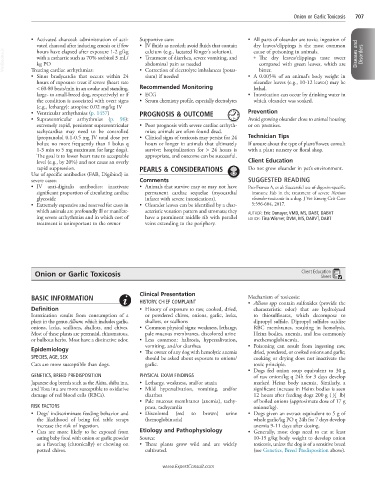Page 1398 - Cote clinical veterinary advisor dogs and cats 4th
P. 1398
Onion or Garlic Toxicosis 707
• Activated charcoal: administration of acti- Supportive care: • All parts of oleander are toxic; ingestion of
vated charcoal after inducing emesis or if few • IV fluids as needed; avoid fluids that contain dry leaves/clippings is the most common
VetBooks.ir with a cathartic such as 70% sorbitol 3 mL/ • Treatment of diarrhea, severe vomiting, and ○ The dry leaves/clippings taste sweet Diseases and Disorders
cause of poisoning in animals.
calcium (e.g., lactated Ringer’s solution).
hours have elapsed after exposure 1-2 g/kg
abdominal pain as needed
kg PO
compared with green leaves, which are
Treating cardiac arrhythmias:
bitter.
sium) if needed
• Sinus bradycardia that occurs within 24 • Correction of electrolyte imbalances (potas- • A 0.005% of an animal’s body weight in
hours of exposure: treat if severe (heart rate oleander leaves (e.g., 10-12 leaves) may be
< 60-80 beats/min in an awake and standing, Recommended Monitoring lethal.
large- to small-breed dog, respectively) or if • ECG • Intoxication can occur by drinking water in
the condition is associated with overt signs • Serum chemistry profile, especially electrolytes which oleander was soaked.
(e.g., lethargy): atropine 0.02 mg/kg IV
• Ventricular arrhythmias (p. 1457) PROGNOSIS & OUTCOME Prevention
• Supraventricular arrhythmias (p. 96): Avoid growing oleander close to animal housing
extremely rapid, persistent supraventricular • Poor prognosis with severe cardiac arrhyth- or on premises.
tachycardias may need to be controlled mias; animals are often found dead.
(propranolol 0.1-0.5 mg IV total dose per • Clinical signs of toxicosis may persist for 24 Technician Tips
bolus; no more frequently than 1 bolus q hours or longer in animals that ultimately If unsure about the type of plant/flower, consult
1-3 min to 5 mg maximum for large dogs). survive; hospitalization for > 24 hours is with a plant nursery or floral shop.
The goal is to lower heart rate to acceptable appropriate, and outcome can be successful.
level (e.g., by 20%) and not cause an overly Client Education
rapid suppression. PEARLS & CONSIDERATIONS Do not grow oleander in pet’s environment.
Use of specific antibodies (FAB, Digibind) in
severe cases: Comments SUGGESTED READING
• IV anti-digitalis antibodies: inactivate • Animals that survive may or may not have Pao-Franco A, et al: Successful use of digoxin-specific
significant proportion of circulating cardiac permanent cardiac sequelae (myocardial immune Fab in the treatment of severe Nerium
glycoside infarct with severe intoxications). oleander toxicosis in a dog. J Vet Emerg Crit Care
• Extremely expensive and reserved for cases in • Oleander leaves can be identified by a char- 5:596-604, 2017.
which animals are profoundly ill or manifest- acteristic venation pattern and stromata; they AUTHOR: Eric Dunayer, VMD, MS, DABT, DABVT
ing severe arrhythmias and in which cost of have a prominent middle rib with parallel EDITOR: Tina Wismer, DVM, MS, DABVT, DABT
treatment is unimportant to the owner veins extending to the periphery.
Onion or Garlic Toxicosis Client Education
Sheet
Clinical Presentation
BASIC INFORMATION Mechanism of toxicosis:
HISTORY, CHIEF COMPLAINT • Allium spp contain sulfoxides (provide the
Definition • History of exposure to raw, cooked, dried, characteristic odor) that are hydrolyzed
Intoxication results from consumption of a or powdered chives, onions, garlic, leeks, to thiosulfinates, which decompose to
plant in the genus Allium, which includes garlic, shallots, or scallions dipropyl sulfide. Dipropyl sulfides oxidize
onions, leeks, scallions, shallots, and chives. • Common physical signs: weakness, lethargy, RBC membranes, resulting in hemolysis,
Most of these plants are perennial, rhizomatous, pale mucous membranes, discolored urine Heinz bodies, anemia, and less commonly
or bulbous herbs. Most have a distinctive odor. • Less common: halitosis, hypersalivation, methemoglobinemia.
vomiting, and/or diarrhea • Poisoning can result from ingesting raw,
Epidemiology • The owner of any dog with hemolytic anemia dried, powdered, or cooked onions and garlic;
SPECIES, AGE, SEX should be asked about exposure to onions/ cooking or drying does not inactivate the
Cats are more susceptible than dogs. garlic. toxic principle.
• Dogs fed onion soup equivalent to 30 g
GENETICS, BREED PREDISPOSITION PHYSICAL EXAM FINDINGS of raw onion/kg q 24h for 3 days develop
Japanese dog breeds such as the Akita, shiba inu, • Lethargy, weakness, and/or ataxia marked Heinz body anemia. Similarly, a
and Tosa inu are more susceptible to oxidative • Mild hypersalivation, vomiting, and/or significant increase in Heinz bodies is seen
damage of red blood cells (RBCs). diarrhea 12 hours after feeding dogs 200 g ( 1 2 lb)
• Pale mucous membranes (anemia), tachy- of boiled onions (approximate dose of 17 g
RISK FACTORS pnea, tachycardia onions/kg).
• Dogs’ indiscriminate feeding behavior and • Discolored (red to brown) urine • Dogs given an extract equivalent to 5 g of
the likelihood of being fed table scraps (hemoglobinuria) whole garlic/kg PO q 24h for 7 days develop
increase the risk of ingestion. anemia 9-11 days after dosing.
• Cats are more likely to be exposed from Etiology and Pathophysiology • Generally, most dogs need to eat at least
eating baby food with onion or garlic powder Source: 10-15 g/kg body weight to develop onion
as a flavoring (chronically) or chewing on • These plants grow wild and are widely toxicosis, unless the dog is of a sensitive breed
potted chives. cultivated. (see Genetics, Breed Predisposition above).
www.ExpertConsult.com

